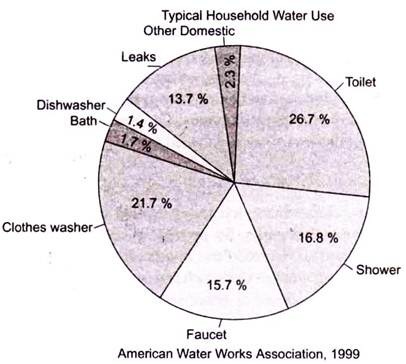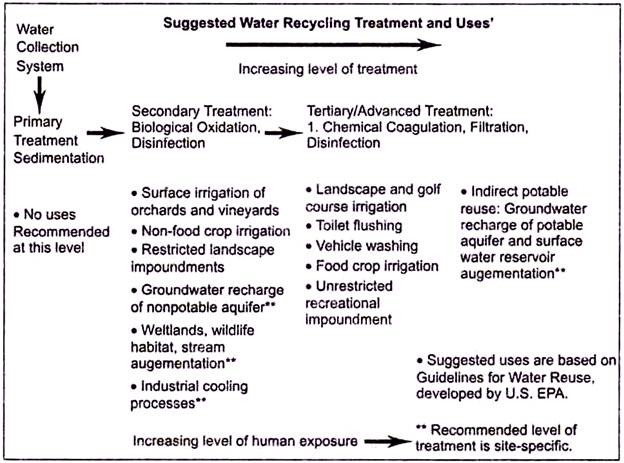Here is an essay on ‘Water Recycling’ for class 8, 9, 10, 11 and 12. Find paragraphs, long and short essays on ‘Water Recycling’ especially written for school and college students.
Essay # 1. Meaning of Water Recycling:
While recycling is a term generally applied to aluminum cans, glass bottles, and newspapers, water can be recycled as well. Water recycling is reusing treated wastewater for beneficial purposes such as agricultural and landscape irrigation, industrial processes, toilet flushing, and replenishing a ground water basin (referred to as ground water recharge).
Water is sometimes recycled and reused onsite; for example, when an industrial facility recycles water used for cooling processes. A common type of recycled water is water that has been reclaimed from municipal wastewater, or sewage. The term water recycling is generally used synonymously with water reclamation and water reuse.
Through the natural water cycle, the earth has recycled and reused water for millions of years. Water recycling, though, generally refers to projects that use technology to speed up these natural processes. Water recycling is often characterized as “unplanned” or “planned.”
A common example of unplanned water recycling occurs when cities draw their water supplies from rivers, such as the Colorado River and the Mississippi River, that receive wastewater discharges upstream from those cities. Water from these rivers has been reused, treated, and piped into the water supply a number of times before the last downstream user withdraws the water. Planned projects are those that are developed with the goal of beneficially reusing a recycled water supply.
Essay # 2. Benefits of Recycled Water:
Recycled water can satisfy most water demands, as long as it is adequately treated to ensure water quality appropriate for the use. In uses where there is a greater chance of human exposure to the water, more treatment is required. As for any water source that is not properly treated, health problems could arise from drinking or being exposed to recycled water if it contains disease-causing organisms or other contaminants.
The US Environmental Protection Agency regulates many aspects of wastewater treatment and drinking water quality, and the majority of states in the US have established criteria or guidelines for the beneficial use of recycled water.
In addition, in 2004, EPA developed a technical document entitled “Guidelines for Water Reuse,” which contains such information as a summary of state requirements, and guidelines for the treatment and uses of recycled water. State and Federal regulatory oversight has successfully provided a framework to ensure the safety of the many water recycling projects that have been developed in the United States.
Recycled water is most commonly used for nonpotable (not for drinking) purposes, such as agriculture, landscape, public parks, and golf course irrigation. Other nonpotable applications include cooling water for power plants and oil refineries, industrial process water for such facilities as paper mills and carpet dyers, toilet flushing, dust control, construction activities, concrete mixing, and artificial lakes.
Although most water recycling projects have been developed to meet nonpotable water demands, a number of projects use recycled water indirectly for potable purposes. These projects include recharging ground water aquifers and augmenting surface water reservoirs with recycled water. In ground water recharge projects, recycled water can be spread or injected into ground water aquifers to augment ground water supplies, and to prevent salt water intrusion in coastal areas.
For example, since 1976, the Water Factory 21 Direct Injection Project, located in Orange County, California, has been injecting highly treated recycled water into the aquifer to prevent salt water intrusion, while augmenting the potable ground water supply.
While numerous successful ground water recharge projects have been operated for many years, planned augmentation of surface water reservoirs has been less common. However, there are some existing projects and others in the planning stages.
For example, since 1978, the upper Occoquan Sewage Authority has been discharging recycled water into a stream above Occoquan Reservoir, a potable water supply source for Fairfax County, Virginia. In San Diego, California, the Water Repurification Project is currently being planned to augment a drinking water reservoir with 20,000 acre-feet per year of advanced treated recycled water.
Essay # 3. Environmental Benefits of Water Recycling:
In addition to providing a dependable, locally-controlled water supply, water recycling provides tremendous environmental benefits. By providing an additional source of water, water recycling can help us find ways to decrease the diversion of water from sensitive ecosystems. Other benefits include decreasing wastewater discharges and reducing and preventing pollution. Recycled water can also be used to create or enhance wetlands and riparian habitats.
a. Water Recycling Can Decrease Diversion of Freshwater from Sensitive Ecosystems:
Plants, wildlife, and fish depend on sufficient water flows to their habitats to live and reproduce. The lack of adequate flow, as a result of diversion for agricultural, urban, and industrial purposes, can cause deterioration of water quality and ecosystem health. Water users can supplement their demands by using recycled water, which can free considerable amounts of water for the environment and increase flows to vital ecosystems.
b. Water Recycling Decreases Discharge to Sensitive Water Bodies:
In some cases, the impetus for water recycling comes not from a water supply need, but from a need to eliminate or decrease wastewater discharge to the ocean, an estuary, or a stream. For example, high volumes of treated wastewater discharged from the San Jose/Santa Clara Water Pollution Control Plant into the south San Francisco Bay threatened the area’s natural salt water marsh.
In response, a $140 million recycling project was completed in 1997. The South Bay Water Recycling Program has the capacity to provide 21 million gallons per day of recycled water for use in irrigation and industry. By avoiding the conversion of salt water marsh to brackish marsh, the habitat for two endangered species can be protected.
c. Recycled Water may be Used to Create or Enhance Wetlands and Riparian (Stream) Habitats:
Wetlands provide many benefits, which include wildlife and wildfowl habitat, water quality improvement, flood diminishment, and fisheries breeding grounds. For streams that have been impaired or dried from water diversion, water flow can be augmented with recycled water to sustain and improve the aquatic and wildlife habitat.
Water Recycling Can Reduce and Prevent Pollution-When pollutant discharges to oceans, rivers, and other water bodies are curtailed, the pollutant loadings to these bodies are decreased. Moreover, in some cases, substances that can be pollutants when discharged to a body of water can be beneficially reused for irrigation.
For example, recycled water may contain higher levels of nutrients, such as nitrogen, than potable water. Application of recycled water for agricultural and landscape irrigation can provide an additional source of nutrients and lessen the need to apply synthetic fertilizers.
Essay # 4. Future of Water Recycling:
Water recycling has proven to be effective and successful in creating a new and reliable water supply, while not compromising public health. Non-potable reuse is a widely accepted practice that will continue to grow. However, in many parts of the United States, the uses of recycled water are expanding in order to accommodate the needs of the environment and growing water supply demands. Advances in wastewater treatment technology and health studies of indirect potable reuse have led many to predict that planned indirect potable reuse will soon become more common.
While water recycling is a sustainable approach and can be cost-effective in the long term, the treatment of wastewater for reuse and the installation of distribution systems can be initially expensive compared to such water supply alternatives as imported water or ground water. Institutional barriers, as well as varying agency priorities, can make it difficult to implement water recycling projects. Finally, early in the planning process, agencies must implement public outreach to address any concerns and to keep the public involved in the planning process.
As water demands and environmental needs grow, water recycling will play a greater role in our overall water supply. By working together to overcome obstacles, water recycling, along with water conservation, can help us to conserve and sustainably manage our vital water resources.

